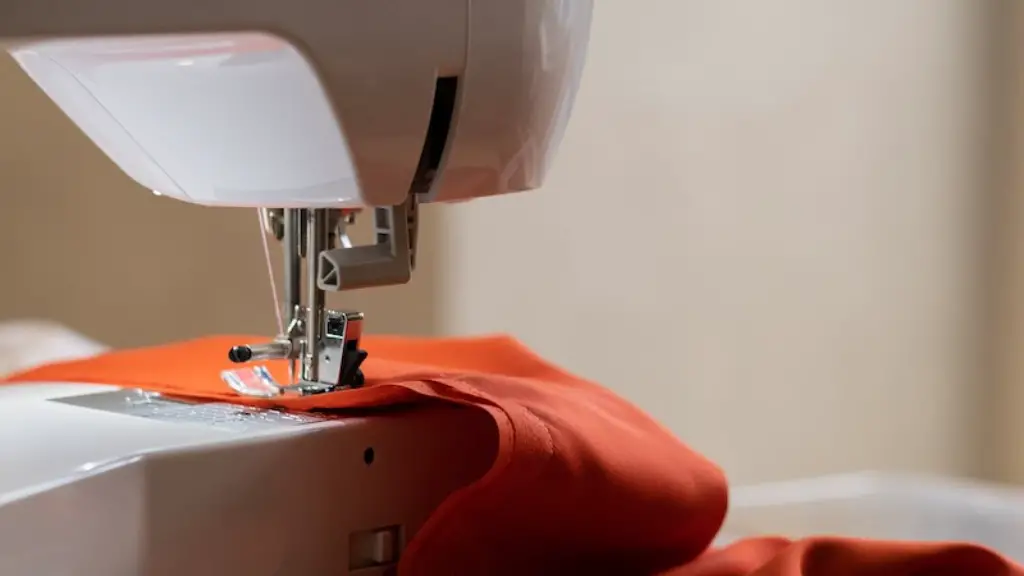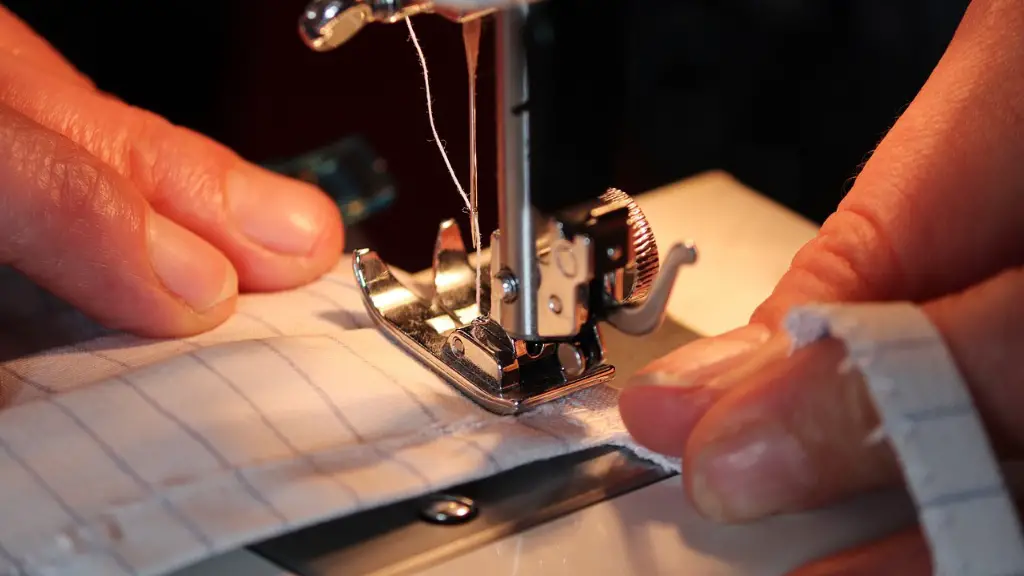Quilting is an art form that has been around since the dawn of civilization, originating in the Middle East and India. It is a form of needlework that requires the use of a fabric block or sandwich stitched together with a quilting stitch, often through the layers of material. It has become a popular way for creative crafters to create beautiful, colorful designs for bedding, clothing and wall hangings. The question of whether one can quilt on a sewing machine has a surprisingly intricate answer.
Sewing machines have been around since the early 19th century and can be used for a variety of sewing tasks. Depending on the type of machine and its capabilities, it is possible to use a sewing machine to quilt. Quilting machines are specifically designed to produce a very high-quality quilting stitch, but they come with a much heftier price tag. If you already have a sewing machine, it is possible to use it for quilting but you may have to make a few updates or purchase a few accessories to make the experience better.
The primary benefit of using a sewing machine for quilting is that it is usually much faster and requires less skill than traditional quilting done by hand. Sewing machines are designed to automate stitching projects and make them faster and much more efficient. That’s why they are so popular in the quilting and home decor industries. Modern machines feature a variety of settings and speeds, meaning they can handle a wide range of quilting jobs such as outlining patches and completing straight lines.
When it comes to quilting on a sewing machine, the type of machine you have makes a big difference. While most modern machines come with a quilting-capable option, you can also buy dedicated quilting machines that are specifically designed for quilting. These machines come with longer bobbins and larger shuttle hooks, which provide longer stitches and can handle bulky quilt batting better than a standard sewing machine. They also come with specialized features such as automated seam guides, fabric rolls, and quilt pattern templates.
In addition to a good machine, it is important to use quality materials for your quilting project. Quilting requires a great deal of work, and low-quality materials can make the project much harder, and even ruin it. Investing in good fabrics, batting, and thread will ensure you get the best results from your quilting project.
Using a sewing machine for quilting may seem intimidating to some, but it doesn’t have to be. With the right machine, materials, and techniques, sewing machines can be a great way to create beautiful quilting projects.
Lines and Designs
When it comes to quilting with a sewing machine, one of the most important things to understand is the variety of lines and designs that can be quilted. There are various methods and techniques that can be used to create a unique design, and many quilters use a variety of different machines to create their quilts.
Sewing machines with a zigzag stitch capability can be used to create a rich texture on the quilt top. This is done by using a continuous outline or quilting line pattern, with small stitches within each outlined shape. This creates a textured look, giving your quilt a unique style. Sewing machines can also be used for quilting with embroidery and applique designs. Applique designs are created by piecing shapes and designs onto your quilt top before stitching.
Another way to add detail to a quilting project is to thread-draw quilt designs. This involves installing a free-motion quilting foot your sewing machine and creating a design with a precisely controlled stitch length. Thread-dancing can also be combined with other quilting techniques such as hand stitching, paper piecing, and machine applique.
Finally, basic straight line quilting is the simplest and oldest form of quilting. This technique involves stitching in straight lines, either by hand or with a free-motion quilting foot. Maintaining consistently spaced, evenly distributed quilting lines can be tricky, but is an essential skill for producing high quality quilts.
Safety and Comfort
When quilting with a machine, it is important to take some precautions to ensure your safety and comfort. Taking the time to familiarize yourself with the machine and accessories, as well as practicing with the fabric and materials, can mean the difference between a successful project and a disaster.
One of the most important considerations for machine quilting is the type of foot you are using. Free-motion quilting feet are specifically designed for quilting purposes, and they can help keep the fabric and batting in place, allowing you to create intricate patterns quickly and easily. It is important to use the right foot based on the type of quilting you are doing; if you are thread-drawing, you will need to use an open-toe or darning quilting foot.
It is also important to consider the size of your project. Machine quilting large quilts can be tricky and time consuming, so it is important to assess the size of your quilt and how much time you need to complete it. If you are inexperienced and quilting a large quilt, it is important to break it down into smaller sections and work on it gradually.
Finally, it is important to ensure you are using the proper posture and sitting in a comfortable position while quilting. It is important to maintain proper posture while quilting and do some basic stretches when your body starts feeling strained.
Tips and Tricks
Quilting on a sewing machine can seem daunting, but with a few easy tips and tricks, you can be quilting like a pro.
One of the first and most important tips is to practice. Quilting on a machine is a skill, and like any skill, it requires practice and patience to develop. Take some time to practice with scraps of fabric, and graduateto larger projects as your skills improve.
The next tip is to keep it simple. Machine quilting is not as complicated as it may appear, so don’t let yourself get overwhelmed. Start out with simple designs and take each step at a time. As you become more comfortable, you can begin to experiment with more complex designs.
Another important tip is to work in small sections. For larger quilts, it can be helpful to break the quilt into smaller sections and work on them individually. This will help keep the fabric taut and make quilting easier.
Finally, it is important to take your time. Rushing through your quilting project can result in poor quality work and mistakes. Set realistic goals and don’t be afraid to take a break if you feel the need.
Quilting Supplies
In order to get the best results when quilting with a sewing machine, it is important to use the right supplies for the job. Here is a brief overview of the supplies you will need for machine quilting.
The most important item you will need is quilting fabric. Quilting fabric is slightly different from regular fabric, as it is designed to be more durable and resistant to shrinking. Quilting fabric comes in a variety of patterns and colors, so you can choose the one that best suits your project.
In addition to fabric, you will need some batting or wadding. Batting is a type of thick, soft material that is used to layer between the quilt top and backing. It helps to give quilts a soft, warm feel and it also helps add stability to the finished quilt. There are many different types of batting, including various blends of wool and cotton.
You will also need some thread, which comes in a variety of colors and weights. It is important to choose the correct weight of thread for the fabric you are using, to ensure that it is strong enough to hold the quilt together. Remember, the thicker the thread, the more durable your quilt will be.
Finally, you will need a good pair of scissors. Quilting scissors are specially designed for fabric cutting, and they make cutting precise shapes and edges much easier than regular scissors. It is important to choose sharp, precise scissors for your quilting projects, as dull scissors can cause fraying and uneven edges.
Maintenance and Care
Like any sewing machine, a machine used for quilting requires regular maintenance to ensure it runs properly. Regular cleaning and oiling of your machine will keep it running smoothly and help prevent any malfunctions or problems.
It is also important to pay attention to the manual or instructions that come with your machine. These can provide helpful tips and troubleshooting advice. Keep in mind that any changes to your machine, even minor ones, can affect the way it works, so be sure to consult your manual before making any adjustments.
Finally, investing in a few additional accessories can help prolong the life of your machine. A cover for your machine will help protect it from dust, dirt, and moisture, while a stitch identifier can help you keep track of the types of stitches you’ve done. Quilting supplies such as cutting mats and pressing boards can also help to make your quilting projects easier and more precise.
Storage and Organization
Organizing your supplies and quilting materials is essential for keeping your projects moving smoothly. A proper storage system can help keep your materials organized and easily accessible. Investing in a few organizational tools such as fabric bins, thread racks, and carrying cases can go a long way in keeping your workspace tidy and organized.
In addition to storing and organizing your quilting supplies, it is also important to ensure your projects are kept safe and out of harm’s way. Consider using plastic containers or boxes to help keep your quilts safe from dust and dirt, and keep them away from areas with high humidity to help prevent mold and mildew.
Finally, use fabric swatch books and pattern books to help store and organize your fabric collections. Fabric swatch books allow you to organize all your fabric in one place, making it easier to find the fabrics you need for your quilting projects. Keeping track of all your fabric can help you to plan out quilting projects quickly and easily.





